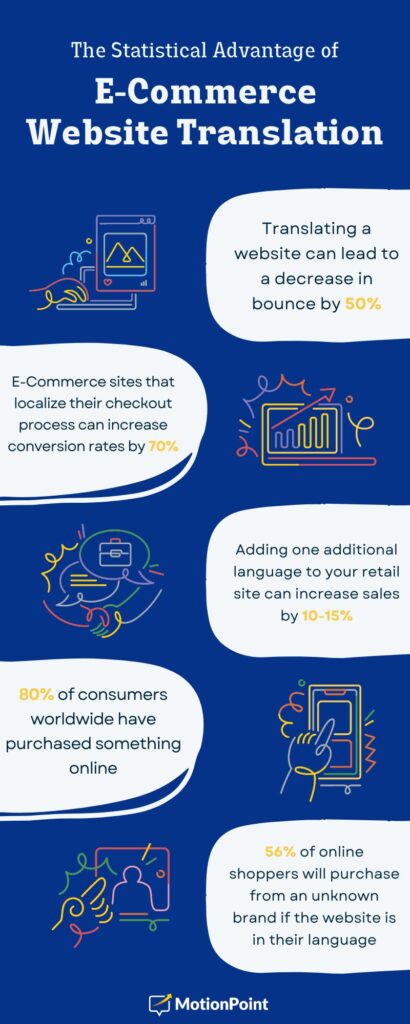The digital age has ushered in a remarkable transformation in how we shop. Gone are the days when physical stores were our only option. Thanks to global health events and the sheer convenience of online shopping as well as website translation services, digital retail has become a preferred choice for millions around the world.
According to a report by eMarketer, global e-commerce sales are expected to reach $9.6 trillion by 2027, marking an impressive growth rate of 47.6% from 2022. With the e-commerce world changing and the desire for multilingual experiences, your online business can’t fall behind when it comes to localization and ecommerce translation.
The Surge in Online Shopping: An Overview
The allure of online shopping lies in its unmatched convenience and the benefits it offers to consumers. Here are the key reasons driving the preference for online over traditional shopping:
Convenience: Online shopping allows consumers to make purchases 24/7, without the constraints of store hours or geographical limitations.
Variety and Selection: Unlike physical stores, online platforms are not limited by shelf space. This enables them to offer a wider range of products, from niche items to global brands.
Greater Accessibility: Customers have a range of options when online shopping, as apps like Instagram, Facebook, and TikTok have incorporated buying functions into their feeds.
Personalized Experiences: Recommendations based on browsing and purchase history make it easier for consumers to find products they love, enhancing the shopping experience and increasing customer satisfaction.
How Does Ecommerce Translation Attract Customers?
The globalization of e-commerce has opened up unprecedented opportunities for businesses to reach customers worldwide. However, to truly connect with a global audience and maximize market penetration, the translation of e-commerce websites into multiple languages is essential.
A CSA Research study showed that 76% of consumers prefer to purchase from a website translated into their language. This is where e-commerce translation plays a pivotal role-not just enabling access, but also building trust and driving conversions. Let’s dig deeper into the invaluable benefits of translating a retail site…

What is E-Commerce Website Translation?
Now that we’ve covered why you should be translating your online store, the next step is taking your website global. E-commerce website translation involves converting the content of an online store or e-commerce platform from one language into another.
Unlike general website translation, ecommerce translation goes deeper-it includes adapting product descriptions, marketing content, legal disclaimers, and customer support messaging to resonate with local audiences. The goal is to make the experience feel native and relevant for every shopper.
This is the foundation of effective e-commerce translation: enabling international customers to interact with your brand as if it were created just for them.
How to Translate Retail E-Commerce Sites
Machine Translation and Post-Editing (MTPE)
Machine Translation and Post-Editing (MTPE) is a powerful solution that blends the speed of automated translation with the nuance and accuracy of human oversight. It is a two-step process designed to optimize the ecommerce translation workflow.
The first step involves using machine translation (MT) technology to translate text from one language to another automatically. This provides a quick and raw translation, which is then refined in the second step through post-editing by human translators.
These professionals review the machine-generated output, correcting errors, and making adjustments to ensure the text is accurate, culturally appropriate, and reads as if originally written in the target language.
Benefits of Using MTPE for E-Commerce Websites
Cost-Effectiveness
MTPE significantly reduces the cost of ecommerce translation compared to traditional methods that rely solely on human translators. By leveraging the efficiency of machine translation for the initial draft, businesses can allocate their resources more effectively, spending on human expertise only for the crucial task of refining and validating the content.
Scalability
E-commerce translation often involves vast volumes of content across multiple languages. MTPE facilitates this by allowing businesses to quickly translate large volumes of text, making it easier to expand into new markets and update content as needed.
Speed
Time is of the essence in e-commerce, where content needs to be updated regularly to reflect changes in products, promotions, and policies. MTPE accelerates the ecommerce translation process, enabling businesses to publish multilingual content faster and respond promptly to market demands.
Tips for Effectively Translating an E-Commerce Website
1. Use a Translation Partner
As you look to expand globally, your business will have many other focuses beyond your website. Partnering with a concierge-level website translation service will ensure your ecommerce translation gets the attention it needs. This will give you access to the translation technology that best fits your business, like MTPE.
2. Identify Your Target Market’s Languages
Before diving into translation, research your target market to determine which languages your website should support. Analyzing your current website traffic can provide insights into potential markets. Additionally, consider the economic potential of countries speaking a particular language and their propensity to purchase your products or services. Smart ecommerce translation strategies are based on real market data.
3. Localize Content Beyond Translation
Ecommerce translation makes your content understandable, but localization makes it resonate. Localization involves adapting your website to reflect local cultural nuances, preferences, and legal requirements. This could mean changing the currency, measurement units, or images to better appeal to the target audience.
4. Ensure Regular Updates and Maintenance
An e-commerce website is a living entity that requires regular updates, especially in fast-moving sectors. Ensure that new products, promotions, and policy changes are promptly translated and localized. Your e-commerce translation workflow needs to support real time updates so that every product and promo is reflected accurately in every language.
MP Concierge for Retail E-Commerce
These tips will help you take the first steps in global retail e-commerce translation success, but your website likely needs help from a professional translation provider. Adaptive Tranlsation™ is the leading translation technology service on the market.
It is specifically tailored to help companies like e-commerce brands thrive in multiple markets for a few reasons:
1. Fast Turnaround Time
MotionPoint’s technology can deploy a new translated website in 60 days or less, with content updates turned around within one business day
2. Customizable Promos for Different Markets
Localization is a big part of e-commerce translation. You may need to customize prices and deal for each market. MotionPoint will be able to help because our linguistic experts can adapt messaging to resonate with different markets.
3. Great Translation Memory
Not all translation services offer translation memory, and those that do often charge you to use it or take it with you if you leave. MotionPoint uses translation memory technology to save you money overtime, storing your translations for later use. This is also a great way to ensure brand consistency.
4. Heavy Content Updates
E-commerce sites deal with constant updates and content changes. This includes new products, product info, price changes, and more.
With MotionPoint’s proxy solution, every product update or new campaign is automatically queued for ecommerce translation, so you never miss a beat in any market.
Grow Your Retail E-Commerce Website
The journey through the intricacies of e-commerce website translation underscores a clear and compelling narrative: the ability to communicate with online shoppers in their native language is not merely an added advantage but a fundamental necessity for businesses aiming to thrive in the global marketplace.
Effective ecommerce translation is more than translating words. It's about understanding the context, culture, and commerce behind every click. When done right, it increases engagement, conversion, and lifetime value from every international customer.
This comprehensive approach not only attracts a broader audience by making your e-commerce platform accessible and engaging to non-English speakers but also fosters trust and loyalty among international customers, thereby enhancing their shopping experience.
Last updated on June 03, 2024